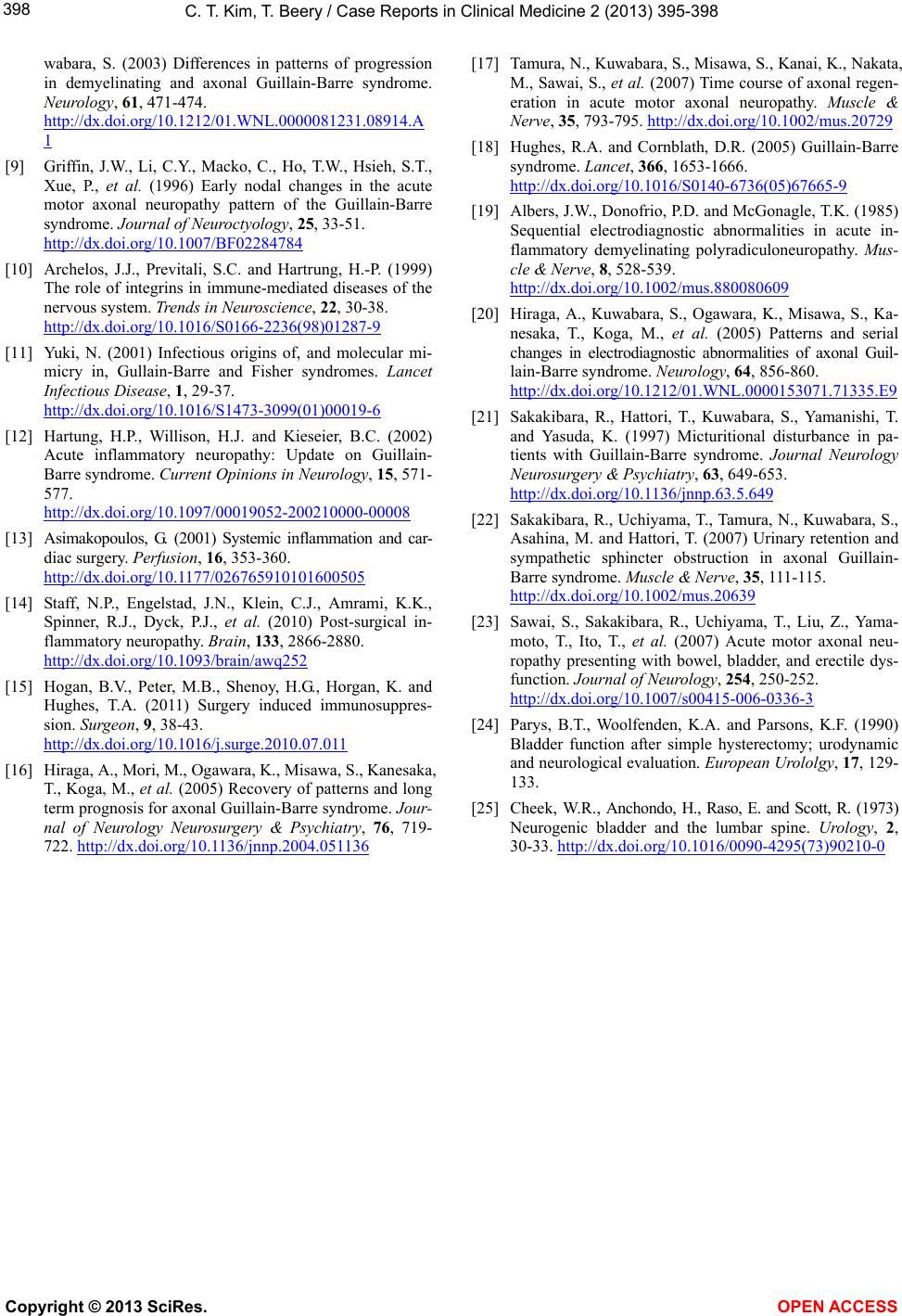
C. T. Kim, T. Beery / Case Reports in Clinical Medicine 2 (2013) 395-398
Copyright © 2013 SciRes. OPEN ACCESS
398
wabara, S. (2003) Differences in patterns of progression
in demyelinating and axonal Guillain-Barre syndrome.
Neurology, 61, 471-474.
http://dx.doi.org/10.1212/01.WNL.0000081231.08914.A
1
[9] Griffin, J.W., Li, C.Y., Macko, C., Ho, T.W., Hsieh, S.T.,
Xue, P., et al. (1996) Early nodal changes in the acute
motor axonal neuropathy pattern of the Guillain-Barre
syndrome. Journal of Neuroctyology, 25, 33-51.
http://dx.doi.org/10.1007/BF02284784
[10] Archelos, J.J., Previtali, S.C. and Hartrung, H.-P. (1999)
The role of integrins in immune-mediated diseases of the
nervous system. Trends in Neuroscience, 22, 30-38.
http://dx.doi.org/10.1016/S0166-2236(98)01287-9
[11] Yuki, N. (2001) Infectious origins of, and molecular mi-
micry in, Gullain-Barre and Fisher syndromes. Lancet
Infectious Disease, 1, 29-37.
http://dx.doi.org/10.1016/S1473-3099(01)00019-6
[12] Hartung, H.P., Willison, H.J. and Kieseier, B.C. (2002)
Acute inflammatory neuropathy: Update on Guillain-
Barre syndrome. Current Opinions in Neurology, 15, 571-
577.
http://dx.doi.org/10.1097/00019052-200210000-00008
[13] Asimakopoulos, G. (2001) Systemic inflammation and car-
diac surgery. Perfusion, 16, 353-360.
http://dx.doi.org/10.1177/026765910101600505
[14] Staff, N.P., Engelstad, J.N., Klein, C.J., Amrami, K.K.,
Spinner, R.J., Dyck, P.J., et al. (2010) Post-surgical in-
flammatory neuropathy. Brain, 133, 2866-2880.
http://dx.doi.org/10.1093/brain/awq252
[15] Hogan, B.V., Peter, M.B., Shenoy, H.G., Horgan, K. and
Hughes, T.A. (2011) Surgery induced immunosuppres-
sion. Surgeon, 9, 38-43.
http://dx.doi.org/10.1016/j.surge.2010.07.011
[16] Hiraga, A., Mori, M., Ogawara, K., Misawa, S., Kanesaka,
T., Koga, M., et al. (2005) Recovery of patterns and long
term prognosis for axonal Guillain-Barre syndrome. Jour-
nal of Neurology Neurosurgery & Psychiatry, 76, 719-
722. http://dx.doi.org/10.1136/jnnp.2004.051136
[17] Tamura, N., Kuwabara, S., Misawa, S., Kanai, K., Nakata,
M., Sawai, S., et al. (2007) Time course of axonal regen-
eration in acute motor axonal neuropathy. Muscle &
Nerve, 35, 793-795. http://dx.doi.org/10.1002/mus.20729
[18] Hughes, R.A. and Cornblath, D.R. (2005) Guillain-Barre
syndrome. Lancet, 366, 1653-1666.
http://dx.doi.org/10.1016/S0140-6736(05)67665-9
[19] Albers, J.W., Donofrio, P.D. and McGonagle, T.K. (1985)
Sequential electrodiagnostic abnormalities in acute in-
flammatory demyelinating polyradiculoneuropathy. Mus-
cle & Nerve, 8, 528-539.
http://dx.doi.org/10.1002/mus.880080609
[20] Hiraga, A., Kuwabara, S., Ogawara, K., Misawa, S., Ka-
nesaka, T., Koga, M., et al. (2005) Patterns and serial
changes in electrodiagnostic abnormalities of axonal Guil-
lain-Barre syndrome. Neurology, 64, 856-860.
http://dx.doi.org/10.1212/01.WNL.0000153071.71335.E9
[21] Sakakibara, R., Hattori, T., Kuwabara, S., Yamanishi, T.
and Yasuda, K. (1997) Micturitional disturbance in pa-
tients with Guillain-Barre syndrome. Journal Neurology
Neurosurgery & Psychiatry, 63, 649-653.
http://dx.doi.org/10.1136/jnnp.63.5.649
[22] Sakakibara, R., Uchiyama, T., Tamura, N., Kuwabara, S.,
Asahina, M. and Hattori, T. (2007) Urinary retention and
sympathetic sphincter obstruction in axonal Guillain-
Barre syndrome. Muscle & Nerve, 35, 111-115.
http://dx.doi.org/10.1002/mus.20639
[23] Sawai, S., Sakakibara, R., Uchiyama, T., Liu, Z., Yama-
moto, T., Ito, T., et al. (2007) Acute motor axonal neu-
ropathy presenting with bowel, bladder, and erectile dys-
function. Journal of Neurology, 254, 250-252.
http://dx.doi.org/10.1007/s00415-006-0336-3
[24] Parys, B.T., Woolfenden, K.A. and Parsons, K.F. (1990)
Bladder function after simple hysterectomy; urodynamic
and neurological evaluation. European Urololgy, 17, 129-
133.
[25] Cheek, W.R., Anchondo, H., Raso, E. and Scott, R. (1973)
Neurogenic bladder and the lumbar spine. Urology, 2,
30-33. http://dx.doi.org/10.1016/0090-4295(73)90210-0